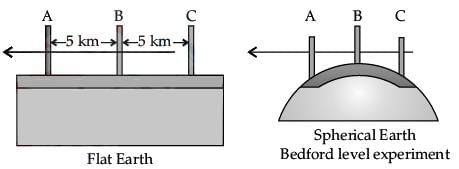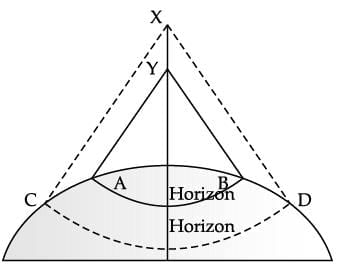Grade 7 Exam > Grade 7 Notes > Science for Grade 7 > Chapter Notes: Earth as a Planet
Earth as a Planet Chapter Notes | Science for Grade 7 PDF Download
Introduction
The chapter "Earth as a Planet" introduces us to the unique characteristics and shape of our planet, Earth. It explores how ancient beliefs about a flat Earth were disproved by scientific observations and experiments, establishing that Earth is a spherical body, specifically an oblate spheroid or geoid. The chapter discusses various proofs of Earth's spherical shape, its position in the solar system, and the factors that make it suitable for life, such as its atmosphere, water, and distance from the Sun. It also highlights Earth's physical features, including its lithosphere and the presence of the Moon as its only natural satellite, emphasizing why Earth is a remarkable planet that supports life.- In ancient times, people believed Earth was flat.
- In India, astronomer Aryabhatta, and in Europe, Pythagoras and Aristotle, were among the first to propose that Earth is spherical.
Proofs of Earth's Spherical Shape
- Sunrise and Sunset: The time of sunrise and sunset differs across locations, indicating a curved surface. If Earth were flat, all places would experience these events simultaneously.
- Sighting of a Ship: When a ship approaches the shore, it becomes visible gradually from the top down, suggesting Earth's surface is curved.

- Bedford Level Experiment: Three poles of equal length were placed 5 km apart in the Bedford Level Canal in Britain, rising to the same height above water, showing alignment consistent with a curved surface.

- Pole Star Position: The Pole Star appears directly overhead at the North Pole, but its angle of elevation decreases as one moves south, indicating a spherical Earth.
- Stars at Night: Different constellations are visible as you move north or south. For example, the constellation Orion appears upside down in Australia compared to the Northern Hemisphere.
- Circular Horizon: The horizon appears circular, and its extent widens with increased altitude, a feature unique to spherical bodies.
- Spherical Earth Horizon Expansion: At higher altitudes, the circular horizon expands from AB to CD, observable only on a spherical Earth.

- Circumnavigation: Ferdinand Magellan’s journey around the world, traveling west and returning to the starting point without encountering an edge, confirms Earth’s spherical shape.
- Varying Time Zones: Different regions experience different times of day due to the uneven distribution of sunlight, supporting the idea of a spherical Earth.
- Lunar Eclipse: During a lunar eclipse, Earth’s shadow on the Moon is consistently oval, indicating a spherical shape. This shadow remains consistent as Earth rotates.
- Varying Star Constellations: As one moves away from the Equator, known constellations shift toward the horizon and are replaced by new ones, a phenomenon not possible on a flat Earth.
- Shadows and Sticks: Shadows cast by sticks in different locations vary in length and angle, unlike what would be expected on a flat surface where shadows would be identical.
- Satellite Pictures: Photographs from space, including those taken by astronauts on the International Space Station, clearly show Earth’s curved surface.
Shape of the Earth
- Earth is not a perfect sphere but an oblate spheroid, bulging at the equator and flattened at the poles.
- This shape is referred to as a "Geoid," meaning "Earth-shaped."
- Earth is the fifth largest planet in the Solar System, with an average diameter of approximately 12,735 km.
- Greek philosopher Eratosthenes made an early attempt to measure Earth’s circumference.
Earth’s Unique Features
- Distance from the Sun: Earth is located 150 million km from the Sun, providing an ideal temperature averaging 17°C, neither too hot nor too cold.
- Atmosphere: Earth has a thick atmosphere with 21% oxygen and 75% nitrogen, supporting life.
- Ozone Layer: The atmosphere contains ozone, which protects life by absorbing harmful ultraviolet rays.
- Water Presence: About 71% of Earth’s surface is covered by water, earning it the names "Blue Planet" or "Watery Planet."
- Lithosphere: The Earth’s rocky surface, called the lithosphere, provides soil for plant life and mineral resources.
- Natural Satellite: The Moon is Earth’s only natural satellite.
- Home to Life: Earth’s unique conditions make it the only known planet capable of supporting human life.
Key Words
- Circumnavigation: Traveling around the world, typically by sailing or other means.
- Lunar Eclipse: When Earth passes between the Sun and Moon, casting a shadow on the Moon.
- Oblate Spheroid: A sphere that is slightly flattened at the poles and bulging at the equator, like an orange.
- Geoid: A term for Earth’s shape, resembling an oblate spheroid due to its rotation.
- Optimum Distance: The ideal distance between objects, such as Earth and the Sun, that supports life.
- Ozone: A gas made of three oxygen atoms that protects Earth by absorbing harmful ultraviolet radiation.
- Ultraviolet Rays: Sunlight radiation that can darken skin and is harmful in excess.
The document Earth as a Planet Chapter Notes | Science for Grade 7 is a part of the Grade 7 Course Science for Grade 7.
All you need of Grade 7 at this link: Grade 7
|
87 videos|198 docs|70 tests
|
FAQs on Earth as a Planet Chapter Notes - Science for Grade 7
| 1. What are some historical proofs that demonstrate the Earth is spherical? |  |
Ans. Historical proofs of Earth's spherical shape include observations by ancient Greek philosophers. For example, Aristotle noted that during a lunar eclipse, the Earth casts a round shadow on the moon. Additionally, Eratosthenes calculated the Earth's circumference around 240 B.C. by measuring the angles of shadows in two different locations in Egypt, showing a difference that indicated a curved surface.
| 2. How does the shape of the Earth affect global phenomena like climate and weather patterns? |  |
Ans. The Earth's spherical shape influences climate and weather patterns by affecting the distribution of sunlight across the planet. Areas near the equator receive more direct sunlight, leading to warmer temperatures, while polar regions receive sunlight at a lower angle, resulting in colder climates. This uneven heating drives atmospheric circulation, influencing weather patterns, ocean currents, and ecosystems.
| 3. What unique features of Earth contribute to its status as a planet capable of supporting life? |  |
Ans. Earth has several unique features that support life, including its liquid water, suitable atmosphere, and moderate climate. The presence of water in liquid form allows for various chemical reactions necessary for life. The atmosphere contains essential gases like oxygen and nitrogen, which protect living organisms from harmful solar radiation and maintain temperature ranges conducive to life.
| 4. How did early explorers contribute to our understanding of Earth's shape? |  |
Ans. Early explorers, such as Ferdinand Magellan, who led the first expedition to circumnavigate the globe, provided practical evidence of Earth's spherical shape. As they traveled westward and returned from the east, it became clear that the Earth is round. Their journeys helped to confirm theories proposed by earlier scholars and demonstrated the vastness of the planet.
| 5. What are some misconceptions about the shape of the Earth that still exist today? |  |
Ans. Common misconceptions include the belief that the Earth is flat or that it is a perfect sphere. In reality, the Earth is an oblate spheroid, meaning it is slightly flattened at the poles and bulging at the equator due to its rotation. These misconceptions often arise from a lack of understanding of scientific evidence and observations that support the Earth's true shape.
Related Searches
















